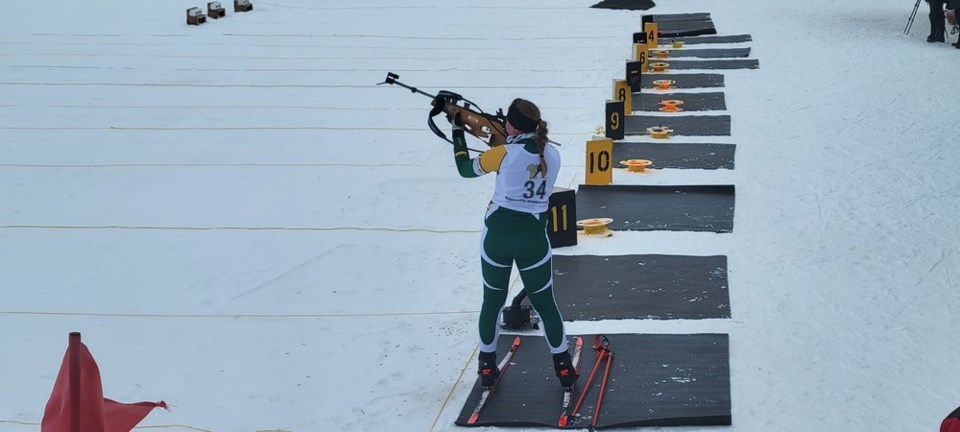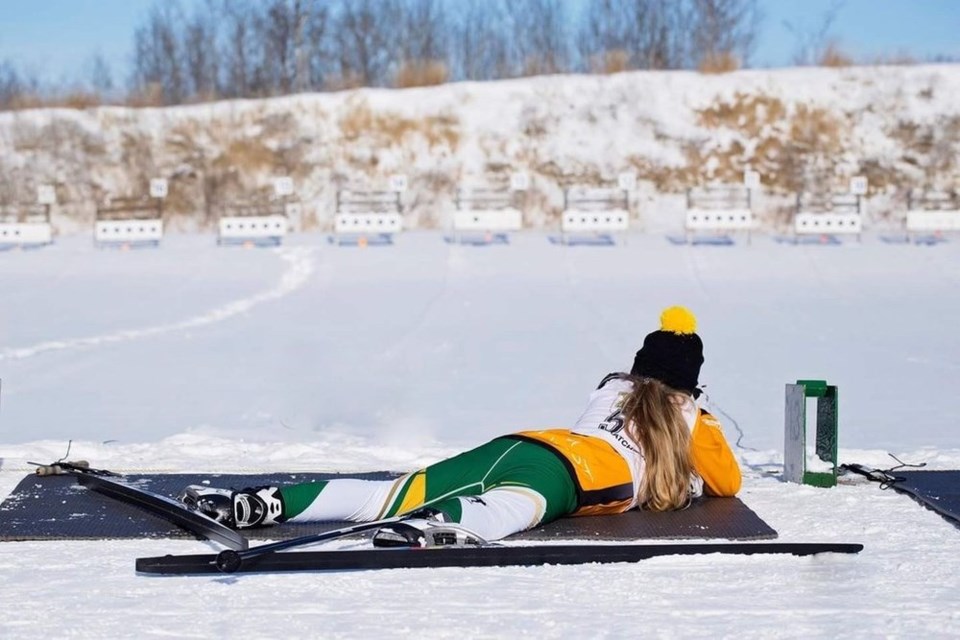As the Winter Olympics wrap up in China there is one local athlete who is about take that next big step towards one day a shot at Olympic gold.
And it is not a winter sport, despite having a Moose Jaw club, many Moose Javians think about. The sport is biathlon and the athlete is Kaycee Nord.
The 16 year old and grade 11 Peacock Collegiate student Nord is set to take her dreams of hopefully someday Olympic success as she is set to compete at the Canadian National Biathlon Championships to be held March 11th - 18th in Prince George, BC.
“I think it will be a pretty fun activity and I will do my best to outshoot them. It is what I can do better,” the aspiring athlete told MJ Independent in a telephone interview.
Nord is one of eight (8) members of the South Saskatchewan Wildlife Association Moose Jaw Biathlon Club. Her dad Curtis is the local coach for all eight athletes.
The sport of biathlon combines cross-country skiing with shooting in what is described by the New York Times as a sport which combines endurance with precision. The winner is decided by the fastest time to finish the course.
Participants in the event must ski a set distance and then shoot at and hit targets. Failing to hit a target results in penalty lap on a small circuit that adds to the athlete’s final time.

Athletes have elevated heart and breathing from the skiing which they have to fight in order to hit the targets and not ski penalty laps.
Nord, who started cross-country skiing at the age of nine, said she took up biathlon at the same time.
“I got onto my first pair of skis the winter I got into biathlon. So it has been seven years (since I started the sport.”
But why biathlon?
“I just found the sport interesting, I guess. My brother was in rodeo and ,” she said about why she initially took up biathlon. And in rodeo they had a shooting event in Pilot Butte and we had to use the Regina Wildlife Federation range. And the head coach for biathlon there asked if he could bring some athletes from Regina there to show kids what biathlon is. And that is how I got into biathlon.”
The sport can be both challenging and relaxing Nord said.
“I enjoy biathlon. It’s different and definitely a challenge and I enjoy that and it is really fun. It’s really fun to do. It’s a really good challenge.”
Despite the misconception that biathlon is not a big sport Nord said her attraction locally is the sport is more like a big family and Canada has had some strong international competitors.

“We had a really good Canadian team in national biathlon world cup and I want to be on that team someday eventually and that is who I look up to. Especially the female athletes because I can relate to them more,” she said.
Canada has had such distinguished female biathlon competitors as Myriam Bedard who won a bronze medal in the 15 km individual event at the 1992 Olympics and later at the 1994 Olympic games won gold in the 7.5 km sprint and the 15 km individual event.
Bedard is the only North American to win a medal - in both male and female events - at an Olympic games.
As a younger girl in the sport her dad Curtis, as well as her coach locally, said his daughter Kaycee “looked up to the older athletes the girls in Saskatchewan.”
“Now she has become one of those girls that the younger generation of girls are starting to see and look up to. Biathlon in Saskatchewan is a small community and its awesome. We call it the biathlon family. Its an excellent environment,” Curt said.
“But that is just how the kids in Saskatchewan. They get started and they see the older athletes compete and it just seems to drive that passion,” he said.
Training for the national championships is intense.
Not only is there shooting practice at the South Saskatchewan Wildlife Association range for the entire Moose Jaw club every Tuesday but there is physical conditioning as well.
She skis everyday - up to 12 kilometers - supplementing it with workouts at the gym three times a week plus a stationary bike in between.
“I try to ski as much as possible, when I can,” she said.

Being in good physical condition is important but so to is the mental aspect of biathlon.
Nord said when you come to the shooting end of biathlon you need to be able to mentally focus on the task while at the same time blocking out the effects of breathing harder, an elevated heart rate as well as being tired because of the sport’s pace.
“You need to have a constant ski race that is not a casual walk in the park type of speed. It is more like me being able to hold that constant race speed. You have to try to develop a skiing strength, the speed and have good cardio to be able to take in that air as much as you can so you can continue to push hard.”
Biathletes in Saskatchewan are trained to use mental imagery of their hitting the targets to help tune out the fatigue and effort of skiing, she said.
“It all depends the athlete’s technique from pushing hard on the trails to shooting clean on the range.”
Additionally the length of trail needed to be traveled in the course of a competition increases as a biathlete grows older.
Asked if there were difficulties being accepted and having facilities because biathlon is not seen as a typical Canadian winter sport such as other sports like hockey and curling Nord said that was true to some extent.
“It is difficult to get ranges started, ranges with good (ski trails and things like that,” she said.
She pointed to the example of how in Moose Jaw the shooting is in an indoor hand gun range not wearing skis. The range can also be crowed with eight club members using the facility, she said.
“In biathlon you shoot with your skis on…but with or practice you can have six kids at the range at one time but skis just get in the way. So we just don’t shoot with our skis on. It is not bad. If you have a lot of kids that are fairly tall there are a lot of overlapping legs,” she said.

The other problem is that until this year, there were no cross-country ski trails in the city which meant travelling to usually Buffalo Pound or Regina to ski.
SEE RELATED - Moose Jaw Trails Great News For Biathletes
“Moose Jaw now has got some trails. It is kind of nice to just have something to go and ski on,” she said, adding “after school and earlier you don’t have to drive anywhere.”
“Yes, I am so happy that we have trails. We haven’t had grooming but the trails are great. the trails that are fairly new they are not too bad.”
Interjecting Curtis said “and Mother Nature has not been super kind to us this year but Kaycee is pumped and all of the other Moose Jaw athletes can’t wait to be able to get out and go with skis.”
The groomed trails established in a partnership between the recently formed Moose Jaw XC Ski Club Inc, Wakamow Valley Authority and City of Moose Jaw has been tremendous because it cuts down on travel enormously.
“Not having to drive to Buffalo Pound, Regina or something like that just to go ski,” is a major benefit re-opening the trails in the Wakamow Valley brings.
Although this will be her first trip to a national finals biathlon is a sport, when compared to other winter sports, where the better and elite athletes are in their mid to late twenties in age.
“It is definitely an older, a late blooming sport,” she said.
She has been on the SaskFirst high performance team for the past three years.
To participate in the Canadian finals she had to first qualify for the event.

Asked by MJ Independent what her thoughts were on this being her first national competition Nord said it was something she was looking forward to and one of the steps she needed to take if she was going to achieve her goal of making the Canadian national team someday.
She said in competitions she had seen the skiing abilities of other biathletes - especially the ones from Alberta - but felt she had a ski up on them because of her shooting ability.
“I think it will be a pretty fun activity and I will do my best to outshoot them (other competitors).It’s what I can do better.”
Curtis said the family was proud of his daughter’s accomplishments.
“We’re all super excited as heck about this and Kaycee is tickled pink to be on the team this year.”




